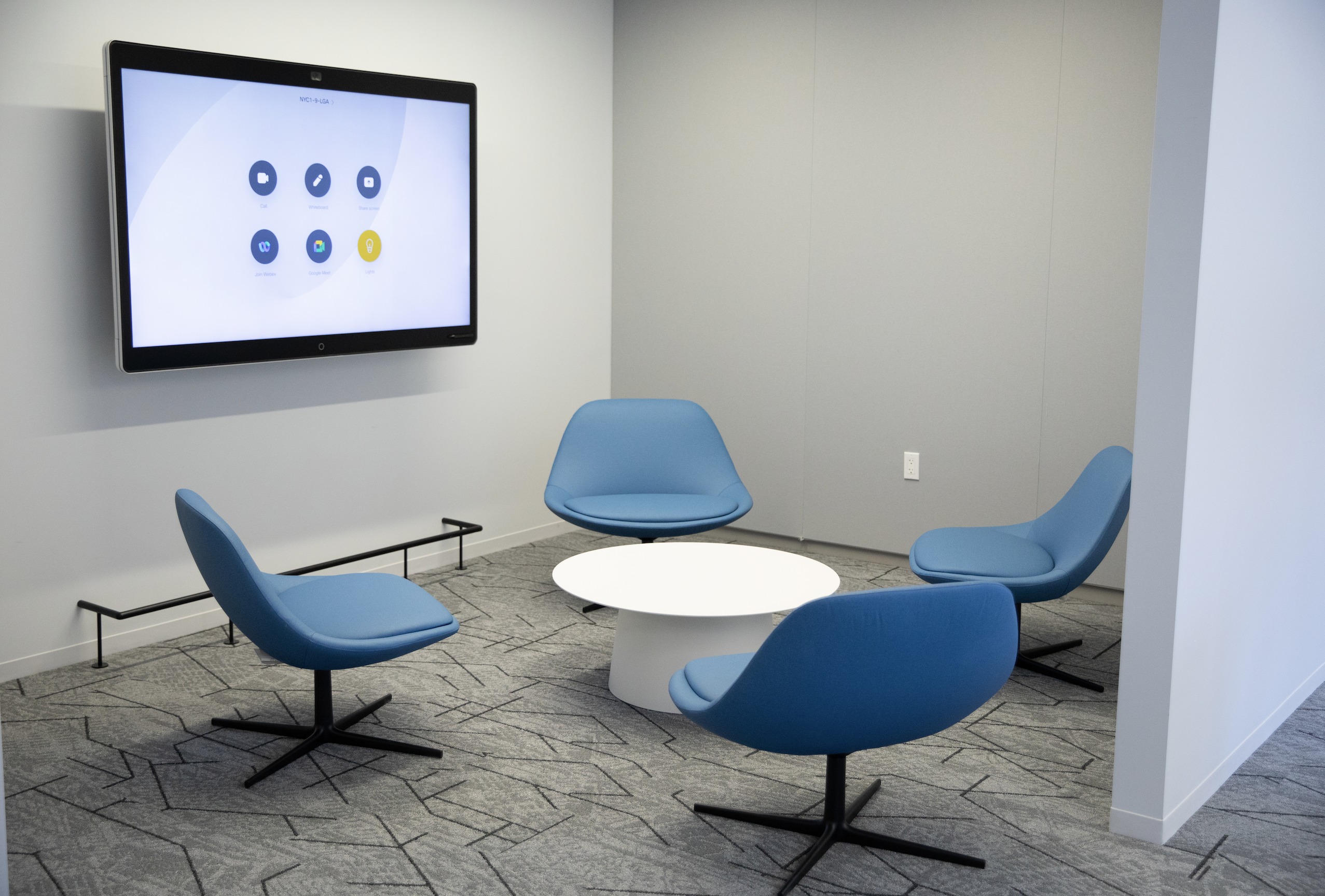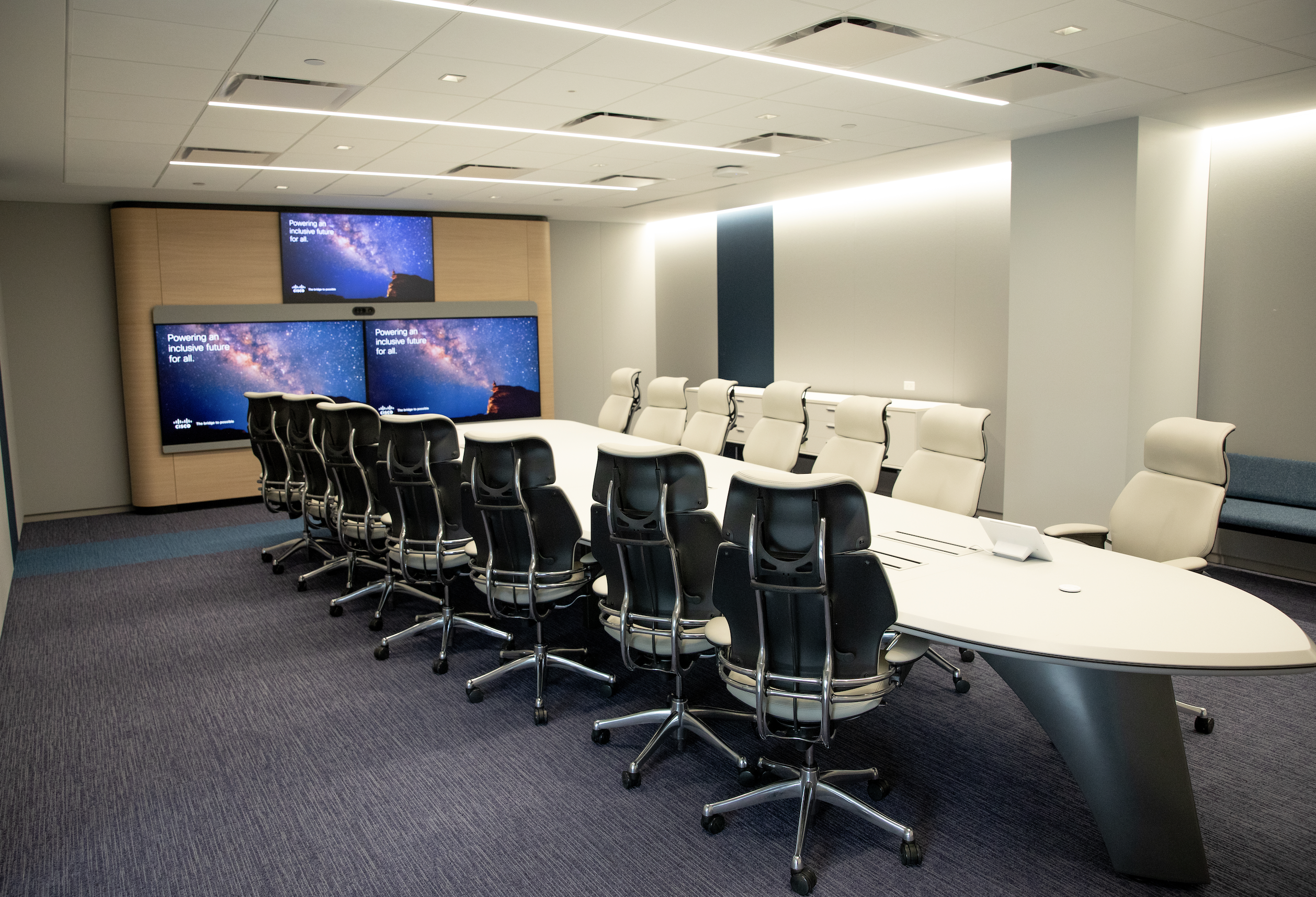![]()
There should be no doubt that hybrid work is here to stay. We are more than two years since the work-from-home period of the pandemic began and businesses have been all over the map with respect to what the return to work looks like. Earlier this year, I was part of UC Today’s UC Summit Keynote, where I stated that the first wave of hybrid work would be a disaster because most business are at a loss as how to proceed.
I’ve had many conversations with information technology leaders, human resources officers and C-level executives that understand the workplace and the way employees work is changing but are unsure as to what that would look like. Cisco Systems Inc. is an example of a global company that historically has had a large percentage of its employees in the office but needs to adapt to the new realities of hybrid work. To accommodate this, Cisco recently completed a two-year project where it revamped its 42,000-square-foot Penn1 location in Manhattan.
Now that it’s completed, Cisco is using its facility not only as an office but also as a hybrid work showcase for its customers, prospects, channel partners or anyone else interested in the future of work. Recently, I was invited to tour the space and see what Cisco has put in place. The tour was conducted by Mark Miller, workplace technology strategist for Cisco, and Javed Khan, senior vice president and general manager of Webex.

Before the tour started, Miller provides me with some of the thought processes that went into the buildout. The first and most major change is that the space had been rebalanced to accommodate a hybrid workforce. This meant adjusting the office from being 70% optimized for individual work and 30% collaboration to 30% individual and 70% collaborative. This is consistent with my thesis that the future of work will look like college.
Think back to your college days and how people did most of their individual work, such as writing papers at home. Then they went to campus to attend classes and meet with colleagues to collaborate on homework or a project. In the in-between times, people would find a quiet place to work, such as the library or cafeteria. With work today, we do much of our writing, spreadsheets and other individual tasks at home and then head to the office to collaborate. During downtime we might find a “phone booth” or desk to catch up on email or other tasks. This was the biggest factor in change in Cisco’s design.
Other project goals:
- Contribute to Cisco’s corporate sustainability goals of achieving net zero by 2040. To accomplish this, Cisco deployed a massive number of “internet of things” devices that includes 100% power over Ethernet where all lights, window shades, thermostats and sensors are powered over the network with low-voltage connections.
- Drive sustainable construction practices. Cisco reduced embodied carbon, leveraged recycled materials where it could and minimized waste.
- A focus on employee well-being. The company is using a mix of technology to maximize natural daylight, provide thermal comfort and monitor and measure air quality. As an example, by default the shades are up to let light in, but when the sun is shining brightly through the window, which heats up the room, the shades will automatically come down.
- Digitization of Cisco’s real estate. This lets Cisco leverage the sensing capabilities of the deployed technology to understand how the real estate is being used, performing and to create new experiences for employees and visitors. Cisco is gathering more than 5,000 data points from Webex devices, Cisco wireless access points, Meraki security cameras and smart building components.
The tour highlighted several different workspaces to facilitate effective collaboration. They included huddle rooms, medium and large rooms and even a boardroom. One of the interesting twists to medium and large meeting rooms was that the tables were all slightly trapezoidal in shape, with the larger side being closest to the camera. This ensures that when people were sitting at the table, they could easily look at others in the room but be slightly pointed to the screen to engage remote participants better.

Cisco also handled hot desking in an innovate way to make it easy. The concept of the hot desk is nothing new but is something most users have disliked because logging into a shared device is generally cumbersome. Because it’s not simple, users will just eschew the infrastructure on their desk and work on their laptop and mobile phone, which is a waste of money.
Cisco has several ways to hot desk that remove almost all the complexity from the complex. Its unique Desk Hub enables workers to place a mobile phone on the it, which logs the user in at that station. Another approach is by plugging a single USB cable into one of the Desk or Desk Pros, which will then log the user in and display the person’s calendar and other pertinent information on the device. Yet another approach is to scan a QR code on the device, which acts as the authentication method. This takes hot desking from being a complicated pin code process to a single click, cable connection or scan.
As one would expect, the office space was Webexed out to highlight much of the recent innovation. Khan ran through a demonstration where the same Webex device could run native Microsoft Teams, Zoom, Google Meet and of course Webex meetings. Although other device manufacturers can connect to multiple providers using SIP, they would need a reboot if one were to say connect to Teams in native mode and then connect to Zoom.
Cisco has put a tremendous amount of effort in not just connecting via SIP but natively interoperating to give the user a rich experience on a single device, regardless of which platform is being used. This might seem counterintuitive for Cisco to do, but openness drives utilization, which is good for the entire industry.
One of the challenges I see for Cisco is how to sell what’s essentially a custom buildout. Khan told me that almost every customer who tours the facility loves the concept and essentially wants to purchase it turnkey. The problem is that there isn’t a hybrid workplace stock-keeping unit that Cisco or its partners could sell.
A complete solution would include floor design, an understanding of how people work, furniture and even things as subtle as where the sun sets and rises to ensure comfortable working conditions. Cisco has always been good at leveraging its channel to scale many of its solutions and architectures, and if it’s going to be successful selling hybrid work, it will need to help its channel work through many of these nuances.
Overall, I enjoyed my tour because it highlighted just how different work will be in the post-pandemic world. The workplace needs to energize people and facilitate creative thinking and the “Office Space”-like “cubetopia” just won’t cut it. I know many companies that have tried to bring people back to the office and had employees say, “Thanks, but no thanks.” In this case, the business needs to look in the mirror and ask: Is this a place the worker would want to come back to?